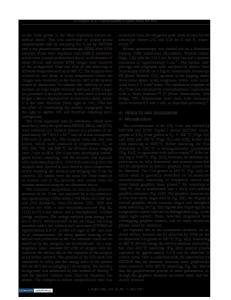Complications of using thin film geometries for nanocrystalline thermal stability investigations
- PDF / 971,120 Bytes
- 11 Pages / 584.957 x 782.986 pts Page_size
- 67 Downloads / 284 Views
Complications of using thin film geometries for nanocrystalline thermal stability investigations Xuyang Zhou1, Tyler Kaub1, Florian Vogel1,2, Gregory B. Thompson1,a) 1
Department of Metallurgical & Materials Engineering, The University of Alabama, Tuscaloosa, AL 35487, USA Institute of Advanced Wear & Corrosion Resistant and Functional Materials, Jinan University, Guangzhou 510632, China a) Address all correspondence to this author. e-mail: [email protected] 2
Received: 6 April 2020; accepted: 19 June 2020
We report the sputter deposition of Cu-7V and Cu-27V (at.%) alloy films in an attempt to yield a “clean” alloy to investigate nanocrystalline stability. Films grown in high vacuum chambers can mitigate processing contaminates which convolute the identification of nanocrystalline stability mechanism(s). The initial films were very clean with carbon and oxygen contents ranging between ∼0.01 and 0.38 at.%. Annealing at 400 °C/1 h facilitated the clustering of vanadium at high-angle grain boundary triple junctions. At 800 °C/1 h annealing, the Cu-7V film lost its nanocrystalline grain sizes with the vanadium partitioned to the free surface; the Cu-27V retained its nanocrystalline grains with vanadium clusters in the matrix, but surface solute segregation was present. Though the initial alloy and vacuum annealing retained the low contamination levels sought, the high surface area-tovolume ratio of the film, coupled with high segregation tendencies, enabled this system to phase separate in such a manner that the stability mechanisms that were to be studied were lost at high temperatures. This illustrates obstacles in using thin films to address nanocrystalline stability.
INTRODUCTION The use of solute segregation has been found to be a means to impede elevated temperature grain growth in nanocrystalline alloys [1, 2, 3, 4, 5, 6, 7, 8, 9, 10, 11, 12, 13, 14, 15, 16, 17, 18, 19, 20, 21, 22, 23, 24, 25, 26, 27, 28]. The solutes can either “wet” the boundary and provide a thermodynamic reduction in the grain boundary (GB) energy that drives coarsening and/or cluster to precipitate as a secondary phase and provide a kinetic pinning effect [4, 25, 29]. Examples of nanocrystalline stability based on these mechanisms have been reported in Ni(P) alloys, [30, 31]; Cu(Ta) alloys [32]; and Cr(W) [33] to name a few. Elucidating the specific details of stabilization mechanisms has been a subject of investigation for many decades [3, 20, 21, 24, 34, 35, 36]. For instance, Cahn, in 1962, described a solute drag effect that originated from a competition between the migration of the GB relative to the diffusivity of a solute into or away from the boundary [34]. In more recent years, the thermodynamics of the solute effect on the boundary energy has been emphasized, where the solute has been proposed to reduce the GB energy to values near zero. This would reduce or even eliminate the driving force for grain growth [3, 12, 20, 21, 24, 35]. These thermodynamic concepts were further
© Materials Research Society 2020
developed by co
Data Loading...










